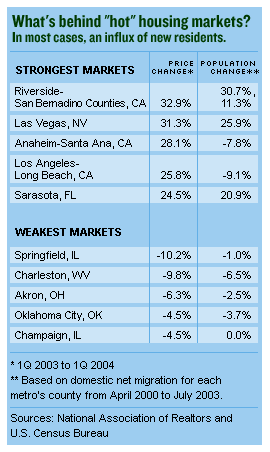
Bend, Ore. (CNN/Money) – People are heading to Las Vegas with hope of hitting the jackpot. They're not on the Strip, but in housing developments in and around the city.
The odds have been good so far. Over the past year, median existing-home prices in Las Vegas have increased 31.3 percent, according to the National Association of Realtors (NAR), and new houses are a hot commodity.
"A subdivision will open with 200 homes and there will be a list with 1,200 people on it," said Las Vegas real estate agent John Carver.
What's the big attraction? "It's not the casinos," he said.
According to Carver, roughly half of the buyers relocating to Las Vegas do so because housing is still relatively affordable there – the median home price is about $225,000 according to the NAR. The job market is also quite strong, thanks in part to all the new residents.
In fact, it's no coincidence that markets with strong home appreciation are also areas that have had an influx of new residents – in most cases drawn by affordable housing. This migration of home buyers is driving up prices in other "hot" housing markets, including Riverside and San Bernardino Counties in California and Sarasota, Fla. (Click here for metro home prices.)
"Back 30 or 40 years ago when people thought about where they'd move it was based on jobs," said University of Michigan demographer William Frey. "Now housing is as much of a factor."
Although a region's job outlook still affects housing prices, the cause and effect are sometimes mixed up.
"In some cases people move to these places not because of a job but because they think they can get more real estate," said David Stiff, an economist for Fiserv CSW. "Sometimes the trend feeds on itself ... more people means more jobs."
The housing frontier
In Las Vegas, new home construction is everywhere, yet builders still can't keep pace with the area's swelling population.

Between 2000 and 2003, according to U.S. Census Bureau estimates, new domestic residents accounted for a 25.9 percent increase in the population of Clark County. (Domestic migration is just one element of population growth. Births, deaths and international migration also factor in.)
Home prices in Riverside and San Bernardino counties in California have increased 32.9 percent over the past year, largely because residents of Los Angeles, Orange County and even San Diego are relocating to these two counties, where the median home price is about $259,000.
"The prices here are still low compared to where people are coming from," said Ron Gerlich, general manager for Coldwell Banker in Riverside. "Some people have sold their houses near L.A. and can come here and pay cash."
Meanwhile, residents of New York and New Jersey are shopping for real estate as far away as North Carolina, South Carolina, Georgia and Florida. Between 2000 and 2003 net domestic migration to Sarasota, Fla., for example, accounted for a 20.9 percent increase in population. As such, home prices there have increased 24.5 percent over the past year.
The housing exodus
| 
| |

| 
| 
|

|
 CNNfn's Kathleen Hays takes a look at which areas of the country will be hardest hit, and what are the trends to be watching in order to get the best price when it comes to selling or buying your home. CNNfn's Kathleen Hays takes a look at which areas of the country will be hardest hit, and what are the trends to be watching in order to get the best price when it comes to selling or buying your home.
|
 Play video
Play video
(Real or Windows Media)
|
| 
|

|
|
On the other side of the equation, more domestic residents seem to be leaving pricier parts of California and New York than are moving in, according to the latest Census data. Property values have not retreated in these areas, however, because the supply of housing is so limited, said Lawrence Yun, NAR economist.
In places where there are fewer supply constraints, though, home prices can go south pretty quickly if demand drops. Both Denver and Salt Lake City have had significant out-migration between 2000 and 2003, and home prices have reflected it. Median prices in Denver were up just 1.1 percent between the first quarters of 2003 and 2004, while prices in Salt Lake City were slightly negative.
| More in Real Estate
|

|
|
|
|
At the same time, the promise of affordable housing has done little to move people to the Midwest, where there have been net migration losses since the Census started collecting that data in 1940s, said Census demographer Jason Schachter. The median home price in Akron, Ohio, for example, is just $104,000, yet home prices have fallen recently and more people seem to be leaving than arriving.
"People are moving out of these regions to the South and the West," said Yun. "They're putting more supply on the market at the same time there is less demand."
Ultimately, said Stiff, home prices track the fundamental economic strength of a metro area. The fact that more people are moving to or from an area is a direct reflection (or cause) of such strength.
But while migration statistics have a close correlation with home prices, they are not very helpful for forecasting future home prices. "The problem with migration numbers is they come out too late," said Stiff.
Besides, trends come and go, even in real estate.
"Economists always say there is a supply and demand equilibrium," said Frey. When home prices get too high in Las Vegas, buyers may find another housing frontier, he said, though he doubts people will be leaving Sin City for Sioux City any time soon.

|